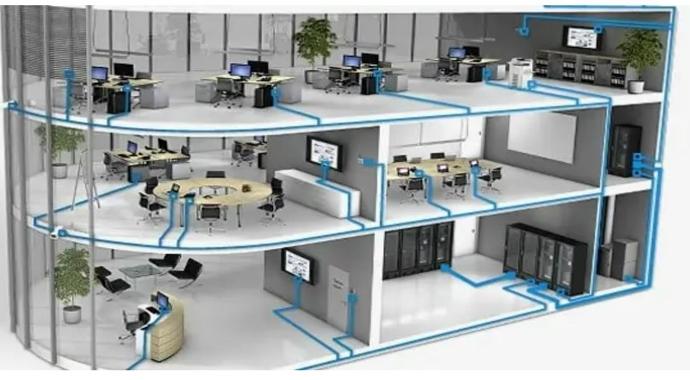
Structured Cabling (LAN)
Structured cabling is the design and installation of a cabling system that will support multiple hardware uses and be suitable for today's needs and those of the future. Structured cabling design and installation are governed by a set of standards that specify wiring data centers, offices, and apartment buildings for data or voice communications using various kinds of cable.
Features
- Resource sharing
All resources are connected to one network, and if a computer needs a resource, it can be shared with another computer. These resources include DVD drives, printers, scanners, modems, and hardware drives. Therefore, there is no need to buy separate resources for each computer, and you can save costs.
- Internet sharing
In offices and Internet cafes, an Internet connection is shared between all computers. This technology is another type of LAN in which the main Internet cable is connected to a server and distributed through the operating system among the connected computers.
- Data security
Data storage on the server is highly secure. If you want to modify or delete data, you can easily do so on a server computer, and other computers can access the updated data. On the other hand, you can allow access to specific users to access the data in the network.
- Enhanced Scalability
Structured cabling allows for easy expansion or modification of systems without extensive rewiring, which can prove costly. As the cabling layout follows a standard design, new components can be added to existing systems without difficulty.
- Greater Flexibility
Structured cabling provides greater flexibility than traditional wiring as it uses fewer cables with more connectors connected along designated pathways. This makes it easier to configure different devices across multiple locations, allowing businesses to quickly adapt their networks as new technologies emerge.
Benefits
- Reliability
Structured cabling is designed to be more reliable than traditional twisted-pair wiring as it utilizes higher-quality cable and connectors. This makes structured cabling ideal for mission-critical systems that require consistent performance over an extended period of time. As the cables are usually organized in vertical columns or horizontal pathways, it's also easier to identify the source of any faults that may occur due to the structured layout.
- Easier Troubleshooting
Faulty connections can be easily identified in a structured cabling environment due to the way that it is laid out. This makes problem diagnosis and repairs faster and easier.
- Easy and fast communication
In local area networks, computers can exchange data and messages easily and quickly. This saves time and gets things done faster. LAN allows any user to share messages and data with any other user on the network. Users can access the network from any computer and access the data stored on the server.
- Cost Efficiency
The scalability and flexibility of structured cabling make it a cost-effective solution for businesses. The cost of installation is also lower than traditional wiring as the layout is predetermined and requires less labor. Additionally, repair and maintenance costs are reduced due to the ease with which faults can be identified.
